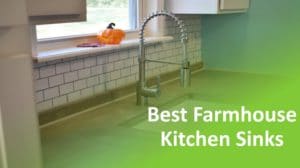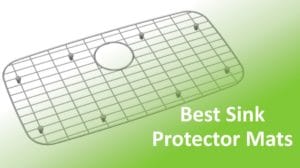Modern kitchens require modern fixtures, including sinks. Stainless steel sinks are still very popular, but they scratch easily, lose their sheen quickly, and often require harsh abrasives to deep clean. Cast iron sinks are ridiculously heavy, porcelain sinks aren’t suitable for the kitchen, and enameled and solid surface sinks are only suitable for light use.
Enter granite composite sinks. These sinks are beautiful, durable, reasonably easy to clean and maintain, and add a touch of modern elegance to your kitchen. You might find yourself considering one, but you should have as much information as possible before buying the best granite composite sink for your kitchen.
See Also: Best Farmhouse Kitchen Sinks | Best Sink Protector Mats
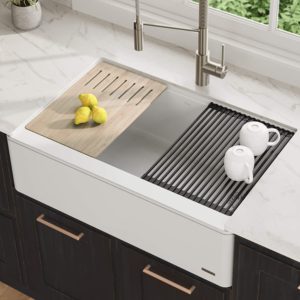
- Material: Granite and Quartz composite
- Installation: Undermount
- Weight: 54.3 pounds
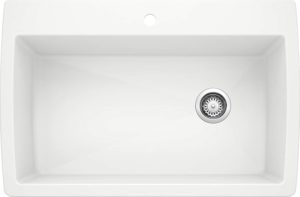
- Material: Granite composite
- Installation: Drop-in or under-mount
- Weight: 45 pounds
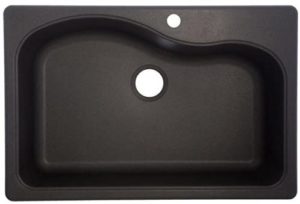
- Material: Granite composite
- Installation: Top-mount or under-mount
- Weight: 43.2 pounds
Top 5 Composite Granite Sinks Reviews
We did extensive research and compiled this list of the five best granite composite sink reviews on the market today.
1. Kraus KGF1-33 Granite Composite Sink

- Fade-resistant color means dark sinks won’t lose their vibrancy, and white sinks won’t turn yellow
- Integrated ledge gives you more working space
- Doesn’t chip or crack easily
- Hardwood cutting board in ledge may crack
- Stainless steel workstation might rust without proper maintenance
- Quite expensive compared to the competition
Kraus’s KGF1-33 granite composite sink uses granite and quartz with acrylic resin, making it resistant to heat up to 650 degrees and able to withstand the temperature shock that comes with changing abruptly from very hot to very cold water.
You’ll also find it resistant to impact, so even if you drop a heavy cast-iron pan, you won’t likely dent, chip, or crack it. Its large, gently sloped bottom with offset drain gives you the space you need to rinse or wash your baking sheets and other large cookware.
Because granite countertops require semi-frequent sealing to keep them looking nice, you might think the same is true of a granite sink. However, Kraus’s composite sinks are smooth and non-porous so liquids bead up and roll off. They stay mostly dry, making cleanup a breeze and virtually eliminating the need to scrub them hard periodically.
If you’re someone who does dishes after the kids have gone to bed, you’ll also enjoy the sound-dampening features of this sink. It mutes the clanging of dropped dishes and absorbs some of the familiar sounds of dish-washing and garbage disposals.
2. BLANCO 440195 Granite Sink

- Depth gives you added space for washing large cookware
- Offset drain allows you to stack dishes without blocking it
- Comes with several options, including sink strainer, cutting board, and professional pull-down faucet
- Requires meticulous measuring due to considerable size
- Doesn’t come with a drain strainer
- May not handle hard water well
This particular sink from BLANCO uses their patented SILGRANIT material for a beautiful look with unmatched durability. SILGRANIT blends granite powder with high-quality acrylic and pigments for unique and stunning looks that won’t burn or blister in extreme heat or crack under extreme cold.
Cleaning is easy, too, with the SILGRANIT material. All you need is water, a sponge, and some baking soda. No harsh cleansers, no need for abrasives that eventually do more damage than good on lesser-quality sinks.
You can install this sink as either a drop-in or under-mount, depending on your particular tastes and your kitchen’s style. Furthermore, this specific BLANCO sink is oversized to handle the largest cookware items in your kitchen. However, their full Diamond line comes in ten styles, so if you prefer a double-basin sink or something else, you can get the same quality sink in any style.
3. Franke Gravity Kitchen Sink

- No-weld manufacturing enhances durability
- Matte look despite the polished finish
- Unique shape allows for mounting closer to the wall without losing the benefits of the sink’s size
- Graphite shade is lighter than pictured
- Depth can create problems with disposal installation and cabinet space
- May scratch with abrasive cleaners
Franke’s gravity kitchen sink is 80 percent quartz bonded with high-quality acrylic resin for a non-porous surface that remains clean and sanitary longer than other sinks.
Franke’s gravity sink’s gently curving shape and depth gives you elegance, style, and functionality. Since it’s a single-basin sink, you can wash trays, baking sheets, large pots and pans, and more.
The sink is gently sloped toward the rear-set drain so water runs to it, but the drain is out of your way while you’re stacking dishes inside. That’s especially handy if you don’t like doing dishes after every single use.
You can install it as a top-mount or under-mount, meaning it goes with your current tastes and styles. It only comes with a faucet hole, but it can accommodate up to three additional holes for things like sprayers and soap dispensers. If you already have a sink that can accommodate those things, you don’t have to worry about giving them up.
4. Ruvati Granite Sink
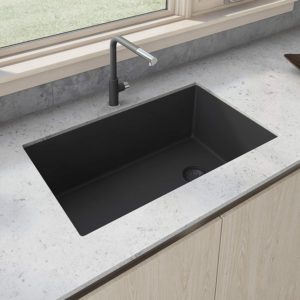
- Includes basket strainer for the drain that traps food and other things
- Gently rounded inside corners make cleaning slightly easier
- Colored all the way through so chips and deep scratches don’t show as easily
- Heavy, weighing in at over 40 pounds
- Must double-check sink code before cutting countertop despite included cutting template
- Drain basket prone to staining
If you’re going for a natural stone look, Ruvati has you covered. They manufacture their sinks using 80 percent granite powder and 20 percent proprietary resin. Because of that, you get a proprietary granite material that helps ensure you have the durability and utility you look for in a sink.
In addition to the manufacturing process that helps eliminate the porous surfaces from which natural stone suffers, Ruvati treats its sinks with a proprietary material to enhance sanitation and resistance to household chemicals and food, drink, and soap. You get a sink that may well be among the easiest granite sinks to keep clean.
Its drain will fit any garbage disposal, although the nine-inch depth of this sink means you should check your under-sink space to ensure your garbage disposal will fit. However, unlike many other granite sinks, this one isn’t huge, so you can install it on your existing countertop.
Like many other granite sinks, this one is dual-mount, so if your old sink hole has the same dimensions required for Ruvati’s sink, you’re in luck. Regardless of what type of mount you may have, all you need to do is to remove your old sink and put this one in.
5. Dekor Composite Granite Sink
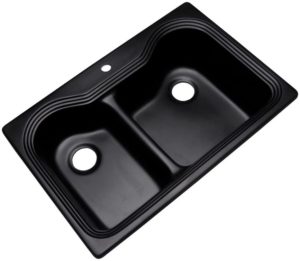
- Water doesn’t stick, so there are no hard water spots
- Drop-in design means no clips are required for installation
- Comes with options for dispenser and sprayer holes
- Requires more silicone sealant upon installation than other granite sinks
- Cannot do under-mount installation with laminate countertops
- Finish may scratch easily
If you want a lighter-weight composite granite sink, check out Dekor’s dual-mount composite granite sink. It comes with a cross-linked fiberglass backing for added durability, resistance to extreme temperature changes, and sound dampening. The backing also helps maintain a steady water temperature when you’re doing dishes.
Depending on your kitchen decor, you may find that this sink’s sheen adds to the beauty of your kitchen. The finish has a subtle sparkle to it that makes it look more like real stone, even on the pitch black and solid white versions.
The finish also helps hide streaks of grease and other things that don’t bead up and dry off, so it looks cleaner than it otherwise would when you haven’t had a chance to clean it. Furthermore, when it is time to clean it, you can use a sponge and simple non-abrasive cleaners on it.
Some granite composite sinks have oddly-sized drains, making connecting a garbage disposal or choosing a basket strainer difficult. This particular sink has a standard-sized drain, though, so you don’t have to buy an adapter for your existing disposal unit or hunt around for a basket strainer that will fit.
What Are Granite Composite Sinks?
Granite composite sinks are 70 to 80 percent crushed or powdered granite or quartz and 20 to 30 percent acrylic resin. To put it another way, they’re engineered stone that’s tougher and more durable than regular stone while requiring less maintenance.
If you have granite countertops, you probably seal them once or twice a year because the stone is porous, so it stains easily. That would be disastrous in a sink, which takes more abuse than a counter ever will.
Granite composite sinks are non-porous, so they don’t soak anything in. Their designs are such that liquids tend to bead up on their surfaces, leaving them mostly dry all the time. Many manufacturers even treat their sinks with specific materials to enhance that feature.
You might discover that some sinks labeled as “granite composite” are actually quartz composite. It’s not false labeling because quartz is one of the many components of the stone known as granite, and there are many similarities. However, you should also understand what you’re getting before you buy it.
You might also find that some granite composite sinks aren’t true composites. These sinks tend to have a fiberglass shell that’s filled and coated with granite composite material. These sinks give you some of the benefits of granite composite while being lighter and possibly quieter.
Differences Between Granite and Quartz Composite Sinks
It’s easy to think that there’s little difference between quartz composite and granite composite sinks. They’re both made from crushed or powdered stone and resin, and both types of rock are hard. So what are the differences?
Quartz Composite Sinks
What are the main differences between granite and quartz composite sinks? Quartz is hard, so quartz composite sinks are tough and resist stains, scratches, and chips. You can drop a heavy dish, like a glass casserole dish, and it probably won’t make a dent, chip, or crack.
However, they’re not quite as hard as granite and are a little more challenging to clean than granite.
On the plus side, these sinks tend to resist fading. Their color generally remains as rich and vibrant as the day you bought and installed it, even with heavy use.
However, you can only get quartz sinks in matte finishes. That might make certain kinds of wear less visible, but other types more visible. Plus, a matte finish may not go with your decor very well.
Remember that a quartz composite sink doesn’t look like quartz the way a natural quartz countertop does. In fact, you might not be able to tell the difference between a quartz composite sink and a granite composite sink at first sight.
Granite Composite Sinks
Granite composite sinks, on the other hand, are harder and tougher than quartz composites. Like quartz, granite composite sinks use crushed rock and resin. They’re molded under high pressure, and the use of granite over quartz makes them harder and sturdier than quartz.
If you thought quartz composite sinks were resistant to scratches, dents, and chips, then you might be surprised at how much tougher granite sinks are. Also, because they’re composites, they have a uniform color just like quartz and only come in matte finishes. However, some granite sinks might have a subtle sheen or sparkle you can’t find with quartz.
Granite composite sinks are more expensive, too, in part because they’re somewhat higher quality than quartz composite. However, both are very unforgiving and likely to damage, or even shatter, dishes as opposed to stainless steel, copper, enamel, and other types of sinks.
Why You Might Choose Granite Composite Sinks Over Others
So why would you choose a granite composite sink over any other sink? Stainless steel and copper work well for all uses and go well with many different kitchen styles. If you don’t use your kitchen much, you can easily get away with enameled, fireclay, and solid surface sinks.
However, all of these require heavier cleaning and are generally higher maintenance than granite composite sinks. With granite composite, you get the durability and beauty of a stone sink without the maintenance hassles, and you get the sound dampening and stain and water-spot resistant finish that copper and stainless steel don’t have.
While composite sinks are more expensive than stainless steel and enameled sinks, they’re considerably less costly than natural stone, copper, and fireclay sinks. So depending on how you plan to use your new sink, you might find that a granite composite sink gives you the best value for your money.
Different Styles of Granite Composite Sinks
You can find granite composite sinks in just about every standard sink style. Double-basin composite sinks are popular, as are single-basin sinks. They can come with a single faucet hole with the space to punch more holes, or you can find them with the number of holes you need. That means you can install soap dispensers and sprayers in addition to your favorite faucet.
They also come as top or under mount granite kitchen sinks, although many these days are dual-mount sinks. Because of that, you can buy one without having to replace your countertop.
Remember that these sinks are far heavier than your standard stainless steel sink or solid-surface sink, sometimes weighing more than 40 pounds. Even if you know how to install it yourself, you probably want someone to help you do so.
Granite Sink Buyer’s Guide
Are you considering buying a granite composite sink already? Since they’re less familiar to many people than the old go-to’s of stainless steel and enamel, we’ve put together some things you should consider before purchasing one.
Cost
These sinks aren’t overly expensive, but they aren’t cheap, either. A high-quality composite sink is considerably more expensive than a stainless steel or solid-surface sink. However, it’s less costly than a natural stone sink, a copper farmhouse sink, and several other types of sinks.
In other words, they’re generally affordable, but as with many things for the kitchen, you get what you pay for. Some of the factors affecting granite composite sink prices include:
- Size (larger, deeper sinks cost more)
- Configuration (triple-basin sinks are less popular and more expensive than single and double-basin sinks)
- Style (top-mount, under-mount, farmhouse)
Under-mount and farmhouse-style sinks cost more than top-mount sinks. Also, keep in mind that if you realize you need a custom-made sink, you’ll pay a lot more for that than you will for pretty much any mass-produced sink.
Advantages and Disadvantages of Granite Composite Sinks
Granite composite sinks give you several advantages over other types of sinks, including:
- Wide variety of colors available
- Heat resistance to 500 degrees Fahrenheit or more
- Sound dampening, making your entire house quieter when you’re doing dishes
- Multiple shapes to fit all manner of cabinet and counter configurations
- Availability in farmhouse and country styles as well as top-mount, under-mount, and dual-mount styles
You’ll find some disadvantages, too. Whether these outweigh the advantages depends on your unique situation. Some of the more common disadvantages are:
- Weighing considerably more than stainless steel and solid-surface sinks, possibly requiring reinforcement for proper support
- Possibility of accumulating hard water stains or salt stains from soft water
- May be damaged with harsh chemicals you might use cleaning other types of sinks
- May chip when impacted with something heavy, like a cast-iron skillet
- Often become dull and hazy without regular care and maintenance
Finally, you’ll probably notice that some sinks come with clips while others don’t. All of them require silicone sealant around the edges and possibly underneath, though. When you’re shopping, ask about installation instructions, including silicone sealants and glues. That way, you don’t end up with a sink that doesn’t work for you.
Granite Sink Cleaning and Maintenance
How do you clean and maintain a granite composite sink?
How To Clean
If you have a high-quality sink and wipe it down regularly, you may not need to do much more than that. Granite composite sinks are hygienic, scratch-resistant, and stain-resistant, so using harsh, antibacterial abrasives on them usually isn’t necessary.
In fact, those kinds of cleaners may actually damage a granite composite sink.
But don’t take for granted the idea that these sinks require little to no maintenance. You may still end up with stains or other problems that require more than a wipedown.
If you need to deep-clean your sink, the first thing you should do is check the manufacturer’s instructions for what you can and cannot use on your particular sink and avoid those they list as potentially harmful for it. They may have a list of cleaning supplies that are easy to use and safe for the sink itself.
If not, you can use regular dish soap and a sponge. It’s unlikely anyone can find a kitchen sink that can’t withstand that. You can also try sprinkling baking soda around the sink, rinsing lightly with vinegar, and then gently scrubbing with a sponge.
Generally, if you stick to a regular cleaning routine, you won’t have to do some of the more challenging work to keep your sink looking clean and beautiful.
General Maintenance
These sinks don’t require the same maintenance that a natural stone sink and countertop require because of their non-porous properties. That doesn’t mean they don’t require maintenance, though.
While you don’t have to perform maintenance regularly, you will eventually notice that your sink gets hazy, faded, or just starts looking permanently dirty. To restore it, you might need to clean it with a restorative cleanser, seal it, and polish it with a product designed to restore granite composite sinks.
It’s not a good idea to do any of this without checking with your manufacturer’s instructions. If you don’t have them, check with your local home improvement store and read the information on whatever supplies you’re considering to be sure they’re suitable for your particular sink.
Frequently Asked Questions
Have some questions? We have some answers to some of the questions prospective buyers ask when considering a granite composite sink.
What’s the difference between a granite and a granite composite sink?
Natural granite sinks are carved from granite slabs. Granite composite sinks are made from crushed granite mixed with acrylic resin. Both are hard, durable, and attractive, but natural granite has color and pattern variations that make each piece unique. Granite composite is uniform in color and pattern, though it may have a subtle sparkle to it.
Natural granite is also harder to maintain because it’s porous. Like a stone countertop, you have to carefully seal it at least once a year, and preferably two to three times a year to prevent permanent staining. You only need to seal a granite composite sink once a year at most.
Remember, this is a sink that takes a lot of abuse. You might end up sealing a natural granite sink more often than you seal the counters around it.
What do I do if my sink becomes hazy and cloudy?
Granite composite sinks become hazy and cloudy for a variety of reasons. Fortunately, you don’t have to worry that your sink is beyond restoration. Better yet, you don’t necessarily have to buy restorative cleansers. You can remove the haze with things you have around your house.
Get some regular dish soap and a non-abrasive scrubbing pad. Scrub the hazy areas of your sink with the soap and scrubber, rinse, and dry periodically until the sink appears clean again.
Then take some olive or mineral oil, apply it to a dry cloth, and use it to polish the inside of your sink. Allow it to sit for a couple of minutes, and then use the dry parts of the cloth to gently buff away the extra oil and restore the shine.
To avoid having to do this in the future, purchase a sealant labeled for granite composite sinks and seal it once a year or so.
Should I get a dark or a light sink?
That depends on your decor. However, if your kitchen decor is such that pretty much any shade will work, consider that darker sinks will show water spots, and lighter sinks will show scratches.
While you can repair deep scratches with special repair kits, surface scratches may remain no matter what you do. So if you can choose between light or dark, keep that in mind.
Are granite composite sinks heavy?
They’re definitely heavier than more common sinks like stainless steel. Depending on its full composition and its overall size, a granite composite sink can weigh 40 pounds or more. Consider calling a home improvement or kitchen remodeling specialist to find out if you need to do any reinforcement work before installing a granite composite sink.
Final Thoughts
There is a lot to think about before buying the best granite composite sink. What kind of sink do you have? What do you want? Can your kitchen accommodate it? You have so much to consider before you settle on a sink.
Once you’ve given everything thought and done your research, you can check out these granite sink reviews to help narrow down your search. We can’t tell you which one is the absolute best because too many factors are involved, but now you have the information you need to make the best decision for your kitchen.



